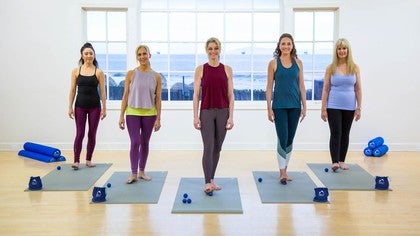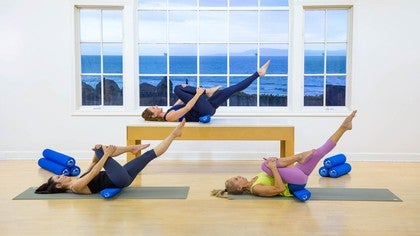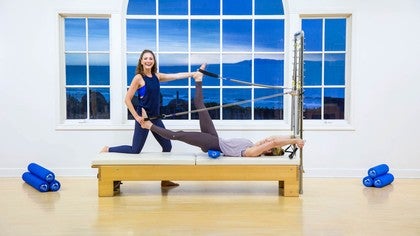Description
Note: Sue recommends using MELT Treatment Balls for this class.
About This Video
Transcript
Read Full Transcript
Just like any MELT mat, we're gonna start with a basic assessment and what I want you to assess is your autopilot to see if it's functioning efficiently or if some stress is causing some interference in your body's ability to function efficiently. So to do a body scan assessment, I want you to assess with me for a second. I want you to put your feet side by side. I want you to look down at your feet and I want you to line them up and convince yourself, your feet are hip width apart, and they're both pointing straight ahead. Once you have your feet in place, we're gonna take two common senses out of the equation.
The first is touch, so bring your arms to your side and then close your eyes and I want you to keep your eyes closed for about 90 seconds. Take a focus breath and I want you to go into your body and sense what you feel, and I want you to begin by noticing your footprints on the floor and without fidgeting or adjusting or shifting your body weight, I want you to notice the footprints and if you're feeling like one foot has a little bit more weight than the other or if you're noticing a region of one of your feet feeling more pronounced to the ground, that's what we call autopilot inefficiency. You're feeling like that ground reaction for us is a little bit out of balance. Another way you can sense inefficiency is scan up your legs. If I say relax your thighs and your butt cheeks or quite locking out your knees, if you just voluntarily softened some muscles, you're feeling how much those muscle movers are working even if you're staying in an upright posture and you're not moving.
Also, draw your awareness back down to your legs. You put your feet side by side, but do your legs feel side by side, or are you noticing that one leg feels like it's staggered in front of the other? If you're noticing that, that's another way to identify this inefficiency in your autopilot. Finally, let's challenge the autopilot. I want you to lift all 10 toes off the ground and notice how your body adjusts and reacts to that position.
Stay there for about 10 seconds to enhance your autopilot's connection to the center of your feet and then try to balance your masses and spaces over that small base of support. Take a nice focus breath. And on an exhale, drop your toes. Notice if your body drifts forward. Open up your eyes.
Did you guys feel yourself drift a little bit? So if you're noticing a drift, that's not a crisis, but I just want you to point out how much we use vision to keep ourselves standing upright. Keep your arms at your side with your eyes open. Lift all 10 toes. You might find it's a lot easier to balance when your eyes are open.
That's because you're the writing reflexes of your vision. Take a nice breath in and on exhale, drop your toes. You might find that you don't drift at all. So if you're feeling that this is what I can do is heighten your body sense and your auto pilot efficiency, I can't help you with your vision. I know it's not gonna help it either.
So, we're gonna start on our left foot. I want you to begin on your right foot and we're just gonna mirror you so it's easier for you to follow along. I want you to put your left foot about a foot and a half away from the ball and you're gonna bring your forefoot right in front of the ball, try to tickle the absolute center of your foot and once you get the ball there, I want you to slowly try to compress the ball and then shift your body weight back over to your opposite foot, so you're just gonna shift right to left about five to 10 times, kinda like a cat getting comfortable on a nice, soft surface. So we're just gonna sit here and pump the ball to help the autopilot reconnect to the center of our foot and our center of gravity and to also find tolerable compression. So slow down a little bit and see if you can just balance your body weight off from left to right.
Now that you're here, let's help our autopilot reconnect our center of gravity to start to move your joints around any which way you want. So your autopilot kinda works like a GPS system. Your joints are like satellites. So if you sustain compression on one part of your foot and move your joints around for about 10 seconds, it helps your brain figure out where those joints are in relationship to your foot. Then come up to a nice standing position.
Take your left foot, step backward. You can even turn your foot out a little bit and just slide the ball a little bit closer to your heel. Just bring your foot forward and then once you're there, soften your knee and just compress the ball just in front of the heel and then decompress and try it one more time. Compress the ball and then take 50% of your body weight off. Now once you're here, let's practice gliding.
Keep your forefoot on the ground and I want you to begin to bring your foot left to right over the ball. I honestly want you to feel like you're creating an arcing sensation, dropping your heel from side to side. Now once you get that movement going, I want you to try to flatten out the ball and create that left to right motion. This is called gliding. It's a preparatory technique with the soft ball.
Once you get the glide consistent in your pressure, slowly work that ball from left to right all the way to the back of your heel. Once you get to the back of your heel, slowly work your way all the way on back to that point just in front of your heel and once you get back there, I want you to compress the ball and try shearing. I want you to compress the ball and just slightly wiggle your foot left to right. And I kinda want you to see that that ball's really not moving. A shear force is compressing the skin between the ball and your bone.
You're shearing the interfaces between those two surfaces. So you're actually creating a shear effect inside the body. And once you create a shear, the most important thing is that you compress and wait. Kinda like working fluid into a sponge and then squeezing it out so when we let it go, we get the full effect. So now we're gonna rinse.
We're gonna bring the ball to our big toe knuckle. We're gonna push that knuckle up and with that same amount of pressure, we're gonna push the ball and step forward. And we're gonna decompress, put the ball underneath the second knuckle, push that knuckle up and then rinse from toe to heel. And then decompress, see if you can find the knuckle that coincides with your third toe and then rinse and then see if you can find your fourth knuckle that coincides with the fourth toe and rinse and go underneath your pinky knuckle. Same thing, compress and then rinse.
Now pick three areas. Anywhere under your foot and give me three more rinsing passes. So this is like spinning water in a tub. You move it in one direction, all of the fluid will eventually move in that same way. The last technique is called friction.
Very lightly just rub the bottom of your foot with the ball. Remember, the connective tissue, fascia, drains itself through the lymphatic system so as we stimulate the lymphatic system through this vibratory motion, it helps to bring that fluid back to the body. Take a nice breath in and then go ahead and set that ball aside. So let's continue with the large firm ball. And we're gonna basically repeat the techniques that we've just done but we're gonna add another shear called an indirect shear.
So same thing, we're gonna bring our heel behind the ball and we're gonna try to rest the center of our foot over the ball. Try this with me. Soften the knees and round yourself forward. Now, when you round forward, you're gonna feel an increase of pressure. I want you to see if you can find tolerable pressure, soften your knees, and nice and slowly, roll your body up, but don't lose the pressure that you can tolerate on the ball.
Once you're there, curl your toes in like you're making a fist, spread your toes out and then pump them. Try it again. Curl the toes in, open them up, and give it that little wiggle. So this is contracting muscle against the area of compression. This is another way to create that shear effect.
Just for fun. Take that ball and just slide it a little bit closer to your heel where we were when we did gliding and try that shear again, curling the toes in, spreading the toes out and wiggling. That might be a little bit more intense. That's where the tendons branch. So try it one more time.
Curling the toes in, spreading it out and then giving the toes a little wiggle. Wait there for a second. Give the tissue a moment to adapt and then bring your forefoot to the floor, soften your knee and let's practice our gliding again. Now, when we were using the large soft ball, it was a preparatory technique. Now we're gonna use gliding as an investigative touch.
So as you slowly move that ball left to right, I want you to notice if it feels like you've got grains of rice living in your heels. Somebody's put a pencil in there and you're flipping over a speed bump. If you're experiencing that, I'm introducing you to what fascial dysfunction feels like, a stiffening of the tissue. Slowly work that ball all the way to the back of your heel and then slowly work your way back and then when you come to that point just in front of your heel, again, you're gonna compress the ball, and really tiny, you're gonna wiggle your foot left to right. So remember, a mechanical force creating a shear effect between the tissue of your skin and your bones.
You're not really rubbing the ball against your foot. You're trying to shear the tissue creating a twisting action between your foot and the bone of your foot. Compress and weight, take a nice focused breath, and then let's rinse. So now that you know how to rinse, start at your forefoot, big toe kinda gets a push up, and you're just gonna push and step over the ball. Go again, what we're creating is kind of a vortex.
A fluid flow exchange. Just rinsing the tissue through, from toe to the heel. I'm just trying to create that nice, easy rinsing pass. So this is going to create a global exchange to the fluid. We're gonna see if we can get that fluid all the way throughout your spine and the rest of your body.
One more time. And then the last technique was friction, so very lightly, just go ahead and rub your foot with the ball again. So again, stimulating the lymphatic system, trying to drain some of that excess waste and fluid out of the body. Take a nice breath in and then let it go. Okay, so get rid of the ball for a second.
Shake out your feet. And I want you to put your feet side by side and let's just take a quick check in. You might notice that your foot feels different, which I totally appreciate because you're rubbing your foot with a ball, but put your arms at your side and close your eyes. I want you to use your body sense and I want you to scan your legs. Now, I want you to see if you can identify a fluid flow exchange in the connective tissue.
When joints are absent of fluid flow, of connective tissue, you might actually notice on your left leg that you can actually feel your hip, your knee, and your ankle but on the leg that you melled, ideally, it feels more seamless and integrated into the flow so notice if you feel that. Open up your eyes. Do you guys gain a sense of that difference? So if you're feeling that, that's great, but we can also use an assessment of a spine flex and a hip hinge. So try this with me.
I'm gonna turn to my side so you can see me. You're gonna put your hands onto your thighs and you're gonna round your spine up like a candy cane. Once you're there, let your neck dangle and let your fingers hang, and then tip your fingers back. You might notice that your right arm is reaching a bit longer than that, and if you're noticing that, it's a good sign that the fluid's past your hips. If you're not feeling that, no worries.
Just hinge at your hips and come all the way down and notice the tensional pull on the back of your leg. When your fascia's hydrated, the tensional pull with me there. It should just be more seamless. When it's dehydrated, you might feel like you're pulling off of the tendons of your calf and upper hamstring. Soften your knees, take your time and round yourself all the way on back up again.
Did you guys notice any changes on that one? So if you guys are noticing that, let's just try it on the other side, otherwise we're walking the right-hand turn for the rest of the day. Let's give it a whirl here. So again, you're gonna put the ball about a foot and a half away from one foot, so your right foot is about a foot and a half away. The forefoot goes in front of the ball and then nice and slowly, again, you're just gonna compress.
Once you get there, again, like a cat, you're just gonna begin to pump the ball. You'll notice if this foot feels a little bit more tender. Don't think there's anything wrong with you. The next time you do the treatment, maybe you might wanna start on your left foot instead of your right foot, just to balance yourself out. So same thing, we're just gonna find that tolerable amount of pressure.
We're gonna press the ball, sustain the pressure, help our autopilot find our center of gravity once again by moving our joints around, helping our brain figure out where's the center of your foot in relationship to all those other joints in your body. Then come on back on top, take your right foot, step backward, and you're gonna slide your left foot forward so that the ball goes just in front of your heel and again, you're gonna soften your knee and compress that point. And then decompress, try that one more time. Gently compress the ball, but this time, only take half of your body weight back and once you get that halfway back, we're gonna again, start gliding. So then if you want, when you first practice gliding, almost think like you're going over in an arcing motion, trying to drop your heel to either side, but once you get the hang of the movement, you're gonna slide your foot back and forth.
Now notice how my forefoot is staying close. So I'm not doing the dance move the mash potato, it's more like the twist. So the heel is what's going back and forth. Really try to get the hang of that. That's what's important about it.
So now again, we're gonna slowly work that ball back and forth, all the way to the back of our heel and nice and slowly, we're gonna work ourselves all the way back to that point just in front of the heel to prepare the tissue for the next technique called shearing. So again, we're gonna compress the ball and then we're gonna nice and tightly wiggle the foot. It almost feels like you're kind of kneading dough. You can always think in one direction and then the other to get the hang of that one, but again remember that we're not trying to massage the ball on our skin. We're pinning the flesh against the surfaces of the ball and the bone of our heel to try to create the shear force.
And then again, we're gonna compress and wait, give the tissue a moment to adapt. Now let's rinse. So again, you're gonna start at the ball of the big toe, you're gonna push that knuckle up to mobilize the joint and then you're gonna push the fluid flow from toe to heel. So there's another technique called position point pressing and what we're doing here, every time we go into a joint is to mobilize the joint, to signal those sensory nerves called mechanoreceptors in the joints to see if we can create the body weight signaling. We're gonna push.
So if you can find that pinky knuckle, same thing, push it and then rinse. And again, just find a few more spots, just three more rinsing passes now that you have the hang of the motion. Two more. And then one more time. And again, let's practice friction.
A nice balancing and vibratory motion. So take a look at how we're trying to pendulum our leg, trying to keep that leg nice and loose, stimulating that fluid flow and then take a nice focus breath and then again, let that go. Okay so again, set that ball aside, get your large firm ball and again, we just repeat the technique. So you're gonna put your heel behind the ball, the ball goes to the center of the foot, soften your knee, take your time, round yourself down, find a tolerable amount of compression with your knee soft and then nice and slowly roll yourself up without losing that compression. And I want you to come all the way up top.
Let's do the indirect shear. Curl your toes in like you're making a fist and open the toes and wiggle. Try that three times. So this again is an indirect shear and we'll be doing similar techniques on the roller that can also help to induce that fluid flow exchange in the tissue. Now again, if you want, take your heel and just slide it a little bit more forward so that ball goes to that point where we were gliding and try to curl your toes in, open your toes and give it a wiggle and just notice if this region is tender.
This is where the tendons branch into these four little toes of ours. This can get awfully stiff. So same thing, wait there for a second, give the tissue a moment to adapt and then set your toes down to the floor and again, let's start our gliding. So remember, gliding is a preparatory technique when we use the softball, but it's also an investigative touch. So as we create the gliding back and forth again start to notice, don't press harder when you're using the firm ball.
It's already firm enough to get a little bit more of your sense of it, but as you go back and forth, notice if you're feeling, again, kind of like grains of rice in your heel. That is what fascia irritation feels like so I want you to notice if you have it. Slowly work your way back until you're just in front of the heel and once you come back up in front of the heel, pause here for a second and again, give it that little wiggle. So remember, we're shearing the tissue between the skin and the bone. So the ball's really not rubbing against our heel anymore, trying to pin the flesh and create that shear effect against the tissues between the bone and the skin and then same thing, we're gonna compress and wait and then we're gonna rinse.
So again, we're gonna start with the ball at the big toe, give it a little push, soften our knees and we're gonna push the ball down the foot. I want you to notice, as your rinse and this ball should be going straight down your foot. You might notice that the ball kind of traverses, doesn't go straight, and if you're noticing that, perhaps one of the bones called the navicular has dropped a little bit and so it's actually meandering around that bone so notice if you have that, the foot treatment could certainly help to rejuvenate those muscles in our feet. One more time and then the last technique was friction. If you only had 30 seconds a day, this one technique is what I would tell you to do.
I'd tell you to get the ball under your foot, give it a nice pendulum, a light vibration motion, swap sides and do friction on the other side. Watch how you balance, notice how you shake your leg. You might shake your leg really long on one side and on the other side, it's not so much. So try it again. So if you find that on one leg, you can't motor coordinate that movement, then this is also something to practice and again, it's a great way to dump junk waste out of your fascia and into the lymph and it just takes about 15 to 20 seconds a day.
You can just do that one treatment. And then let that go. Okay, so let's set the balls aside. Let's put our feet side by side again. Start just how we did before.
Look down at your feet, obsess, try to get your feet side by side, start with your feet side by side and again, put your arms at your side and close your eyes. So go back again and use your body sense. See if we've helped your autopilot reacquire some better efficiency and some better connection to your center of gravity. At the beginning, I told you to notice your footprints. If they felt off balance before, notice if your footprints feel a little bit more cohesive now.
Scan up your legs. Are you relaxed a little bit more? Do you have to release any muscles? Do you feel a nice, natural relaxation in your body just from doing the treatment? Draw your attention down your legs.
If you started off kinda feeling like your legs were staggard or you're noticing that your legs didn't feel side by side, notice if the legs do now feel more side by side. And finally, lift all 10 toes off the ground again. You might find this time your head shifts back very quickly. That's not a bad result. That's new neurological information getting through the fluid system a little faster.
The body's just gotta organize it. You're catching yourself faster. That's showing an increase of efficiency. Take a nice breath in and on an exhale, drop all 10 toes. Notice if you're decreased your drift or you feel like your head carriage goes forward but your hips go back.
If you're noticed any of those changes, open up your eyes. How do you guys feel? Yeah? So these are things that you can do. This basic treatment is something you can do every day and if you have limited time, instead of using both balls, you can just do the compression techniques of gliding, shearing and rinsing with the softball, swap sides and repeat it on the other side.
That would be a mini performance foot treatment. I hope you enjoyed it.
Mindful Movement: MELT Method®
Comments
You need to be a subscriber to post a comment.
Please Log In or Create an Account to start your free trial.






























